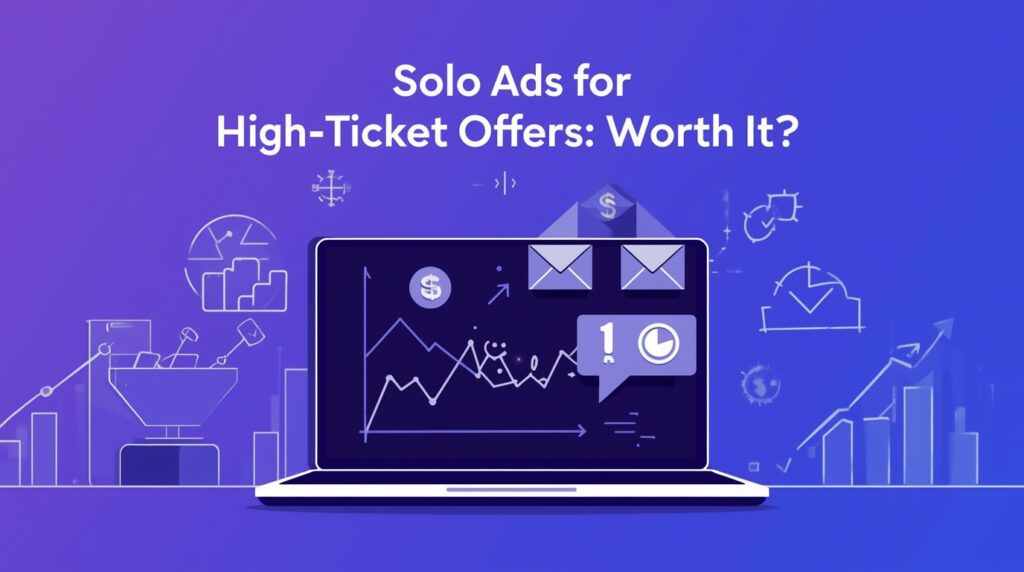
Wondering if solo ads for high-ticket offers can actually sell high-ticket offers? This blog uncovers the truth behind using paid email traffic for premium products. Learn what works, what doesn’t, and how smart marketers turn cold solo ad clicks into high-value sales — without burning their ad budget.
Table of Contents
What Are Solo Ads and How Do They Work?
Solo ads are one of the oldest — yet most underrated — email traffic methods out there. In simple terms, you rent someone’s email list (usually from a niche marketer) and pay them to send your offer directly to their subscribers.
Here’s how it works:
You choose a vendor with a list relevant to your niche.
You provide your email copy and link (to your landing page or funnel).
The vendor sends it to their subscribers, and you get instant traffic.
The beauty of solo ads lies in their simplicity. You don’t need Facebook Ads expertise, no complicated setup — just a solid funnel and a great offer. But when it comes to high-ticket offers ($997, $1997, or more), the game changes drastically.
Why Marketers Use Solo Ads for High-Ticket Offers
Solo ads are a fast way to test an offer and generate leads. For high-ticket products like coaching programs, courses, or done-for-you services, marketers use solo ads primarily for list building and lead qualification.
Instead of trying to make a $2000 sale on the first click (which rarely happens), smart marketers use solo ads to:
Build their email list fast.
Offer a low-ticket or free lead magnet upfront.
Nurture leads through email sequences that lead to discovery calls or webinars.
💡 Example:
A business coach uses solo ads to promote a free “6-Figure Blueprint” PDF. After sign-up, leads enter an automated sequence leading to a free strategy call — where the high-ticket program is pitched.
This method turns cold traffic into warm leads and eventually into paying clients.
The Harsh Reality: Can Solo Ads Really Convert Big Sales?
Let’s be real — expecting direct high-ticket conversions from solo ads is like expecting a first date to turn into marriage. Possible? Sure. Common? Not really.
Solo ads usually bring cold leads — people who don’t know you, your brand, or your offer. Selling a $2000 program directly to them is a long shot.
However, solo ads can still indirectly generate those big sales if used strategically:
Build trust through email sequences.
Offer value first — webinars, case studies, free resources.
Use retargeting through email and social media.
Think of solo ads as a fast pipeline filler — not a direct ATM.
Crafting the Perfect Funnel for High-Ticket Solo Ad Campaigns
If you’re promoting high-ticket offers through solo ads, your funnel is everything.
Here’s a high-performing structure:
Lead Magnet Page – Offer something irresistible (ebook, cheat sheet, webinar).
Thank You Page – A short video building authority and teasing the main offer.
Email Nurture Sequence – 7–14 days of value, stories, and testimonials.
Call-to-Action – Invite them to book a call or join your webinar.
🔥 Example:
A fitness coach promoting a $1,500 transformation program uses solo ads to promote a free “7-Day Shred Plan.” The funnel collects emails, delivers value, and then leads to a personalized coaching call — closing 3–5 clients monthly from solo traffic.
Common Mistakes Marketers Make (and How to Avoid Them)
Even experienced marketers burn money with solo ads by:
❌ Sending traffic directly to a high-ticket checkout page.
❌ Not tracking clicks and conversions.
❌ Using poor vendors with fake or recycled leads.
❌ Failing to follow up with nurturing emails.
✅ How to Fix It:
Always buy solo ads from verified sellers (Udimi or reputable marketplaces).
Use a bridge page to warm up leads before the pitch.
Split-test subject lines, opt-in pages, and lead magnets.
Set up tracking tools like ClickMagick or Qliker to monitor results.
Real Examples: When Solo Ads Deliver (and When They Don’t)
When They Deliver:
A digital marketing coach used $300 in solo ads targeting “make money online” subscribers. He generated 450 leads, booked 8 calls, and closed 2 $1500 clients. That’s $300 → $3,000 ROI.
When They Don’t:
Another affiliate tried selling a $997 crypto course directly through solo ads. Zero conversions. Why? No value build-up, no trust, no nurture — just cold traffic sent to a sales page.
The difference? Funnel + Relationship Building.
The Smart Way to Test Solo Ads for High-Ticket Success
Before scaling, test small. Start with 100–200 clicks, track opt-ins, and analyze engagement.
If your opt-in rate is below 30%, tweak your landing page or headline.
Then, nurture your new leads with:
Automated value-driven email series.
Case studies and success stories.
Free discovery calls or webinars.
Once you find a winning combo, scale slowly and reinvest profits into bigger lists.
Remember: The goal isn’t to sell on Day 1 — it’s to start a conversation that ends with a conversion.
Conclusion
Yes — but only if you play the long game. Solo ads can be a goldmine for generating targeted leads fast, but they’re not a shortcut to instant high-ticket sales.
When used with a strategic funnel, nurturing emails, and genuine value, solo ads can help you build relationships that turn cold clicks into loyal, high-paying clients.
👉 If you treat solo ads as lead generation (not direct sales), they’re absolutely worth it.
FAQ's
Yes, but only when you build an email funnel that nurtures leads before pitching the offer. Direct sales rarely work.
Start small — around $100–$300 for initial testing. Scale only after seeing positive engagement.
Trusted platforms include Udimi, TrafficForMe, and verified vendors with real testimonials.
Aim for 30–50% opt-in rates on your lead magnet page. Anything less may need better copy or targeting.
Solo ads deliver instant traffic, but converting leads into high-ticket buyers may take 7–30 days of nurturing.